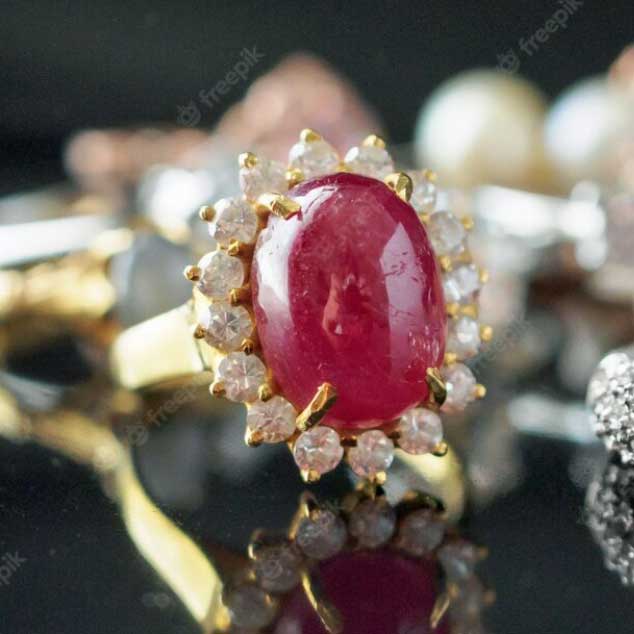RUBIES

Rubies are a type of the three precious colored gemstones with the others being Sapphires and Emeralds. They are a variety of corundum which is a very hard mineral that consists of aluminum oxide which can be synthesized to create rubies and sapphires. Rubies can be recognize by having a pinkish red all the way to blood-red color.
HOW DO WE DETERMINE THE VALIE OF A RUBY
Similar to diamonds we determine the value of a Ruby by use the (4c’s) which are: color, cut, clarity and carat weight; however, unlike diamonds there is no internationally accepted system for this gemstone.
COLOR
Color is considered the most important factor to evaluate a gemstone. It is divided into three components: Hue , Saturation and Tone
Hue: The color as we know it
Saturation: The richness/intensity of the color
Tone: Tone refers to the depth of a ruby’s colour.
The most desired color in rubies is Vivid which seems to exhibit an almost fluorescent quality, lending intense fire to your jewellery. The intense saturation of pure red rubies make them significantly more expensive. If your ruby has strong orange, purple and pink overtones, this will affect long-term value.
CLARITY
As a result of rubies having many inclusion , their clarity is evaluated by the inclusions’ size, number, location, and visibility. The terme “eye-clean” denotes rubies with the highest clarity grades because their inclusions are the least visible to the naked eye.
CUT
Rubies are usually round or oval, but many more cuts exist. Unlike diamonds standardized grading system doesn’t exist.
CARAT WEIGHT
Similar to other gemstones “carat” is used to weigh rubies. While Carat is part of the “4’c” it doesn’t help us asses the quality of a ruby rather it informs us about
the rarity of the gem and its weight.
TREATMENT
The treatment of a ruby is important in order to evaluate its overall value.
Treatment is the cutting and enhancement process which improves the color and clarity of a ruby.
Hypnotic Treatments of Rubies
Besides the 4 c’s and origins, the treatment of any precious stone plays an important role in determining its overall value. Treatment refers to the cutting and enhancement process which is usually done onto a stone to improve the luster and enhance its natural state. Each gemstone has different treatment processes, which is done according to the flaws and requirement lying thereby. When we are discussing ruby, there are mainly 3 types of treatments accessible. These processes not only reduce or remove the number of inclusions or fractures within the stone but also magnify the color of the gem. Let us explore these three main types of treatments in rubies.
1. Heat Treatment
Heat treatment is a very common application on the ground of ruby enhancement. Under this process, the stone of ruby is heated between 800°C to 2,000°C under varying lengths of time from several minutes to several weeks. Heat treatment is mainly carried out to enhance the color saturation of the stone. This treatment is widely found in the stunning red gem, Manik. It is a stable and permanent treatment that is done to remove the blue or brown tint, different color zoning, reduce inclusions, heal fractures, and lighten dark shaded stones.
2. Flux Heat Treatment
Under Flux heating, a flux, such as borax, is added during the regular heating process, so that the higher temperature needed to achieve the desired results of heating can be brought down. Rubies are mainly treated with Flux heat treatment in order to improve the clarity of the gems by healing fractures even with a reduced heat temperature. This treatment also increases the life stability of the stone by sealing the cracks together via flux.
3. Composite or Glass-Filled Treatment
The process of glass filling is another most common type of treatment done on rubies, typically the ones with too many fractures and inclusions. It is done in conjunction with heat treatment. Under this process, lead glass, of a higher refractive index, is melted and filled in breach, cracks, fractures, and inclusions of the ruby stone. Though this treatment is not stable or permanent, it can drastically improve the clarity of inferior quality crystals too. It is mainly carried out on those rough pieces which would otherwise not be suitable to sell.
Now since this is a treatment to fill the stone with melted glass or lead, these rubies are no more considered purely natural, the type and treatment of ruby should be disclosed prior to sale. So that those who are looking out for natural and real rubies, opt only for natural ones from a certified gemstone dealer. However, many people prefer to purchase these composite rubies owing to their affordable price segment.
4. Oil Treatment
Oiling is another commonly practiced treatment in rubies. Rubies are often oiled before the cutting process to ease the exercise of carving. Application of oil is also done after cutting to polish up the results in terms of color concentrations. It is comprehensively a clarity enhancement procedure that improves the clarity of the stone by masking fractures.
DiamondsAntwerp.com only offers natural Rubies.
Fine Jewlery Collections
- Fine Jewelry From Our Atelier
- Custom Designed & Crafted Jewelry
- Unity Collection
- Diamond Bracelets & Bangles
- Diamond Necklaces
- Google Merchant Products
- Wedding & Eternity Bands
- Diamond Engagement Rings
- Diamond Pendants
- Diamond Earrings
- Black Diamond Jewelry
- Diamond & Gemstone Cufflinks
- Video Galleries
- Videos - Diamond Rings
- Videos - Diamond Tennis Bracelets
- Videos - Diamond Eternity Bands
- Videos - Diamond Earrings
- Videos - Black Diamonds & Gemstones
- Video Gallery - Fancy Colored Diamonds
DIAMOND/GEMSTONE EDUCATION
- Jewelry Education Hub
- What Are Diamond Certificates?
- Difference Between Certificates
- Laser Inscribed Diamonds
- Learn About Diamonds – The 4C’s
- Diamond Carat Weight
- Diamond Color
- Diamond Clarity
- Diamond Cut
- Diamond Polish
- Diamond Symmetry
- Diamond Sizes in MM
- Know Your Ring Size
- Understanding Gemstones
- Types Of Gemstones
- Precious Gemstones - Rubies, Sapphires and Emeralds
- Sapphires
- Rubies
- Emeralds
- Treatments & Enhancements
- Birthstones and Their Significance
- Gemstone Grading
- Lapis Lazuli
GENERAL INFORMATION
- MyAntwerpDiamonds Information
- Terms and Conditions
- Contact MyAntwerpDiamonds.com
- Refund Policy
- Customer Reviews
- Shop with Confidence
- Purchase Pointers
- Shipping Information
- VAT Refunds and VAT Free Diamond Jewelry
- USA – Tax Free Diamond Jewlery
- UK – Tax Free Jewelry
- Switzerland – Tax Free Diamond Jewelry
- Australia – Tax Free Diamond Jewlery
- Privacy & Cookies Policy
- User Account
MyAntwerpDiamonds.com /
- sales +32 473 21 02 44
- sales +32 473 21 02 44
- administration +32 3 231 1643
- SUPPORT@myantwerpdiamonds.com
- NV JOAILLERIE FRÈRES FROHMANN, Pelikaanstraat 54, 2018 Antwerp, Belgium
Some email responses from us may be filtered as spam or blocked altogether. To ensure you receive our emails, please provide your telephone or WhatsApp number for verification.



